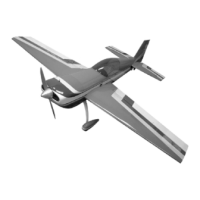Wingspan: 68”
Length: 61”
Weight: 7.5-8.5 lbs.
Engine Size: 2-cycle .60 -.90
4-cycle .90 -1.20
KIT K-55
INSTRUCTIONS
If there’s an aerobatic subject that can challenge the thrill of the Goldberg Ultimate, it’s this Extra 300! The Extra’s generous
moments, light wing loading and strong airframe make it an excellent airplane for the aerobatic pilot, whether he is learning
his first maneuvers or is an unlimited class competition flyer.Yet with all it’s aerobatic potential, this is still a very well-behaved
aircraft, making takeoffs and landings a breeze. And when it comes to engines
, please note: bigger is not better. A good .60
will do an excellent job. A larger than recommended engine may overly stress your model, causing structural failure.
WARNING
A radio-controlled model is not a toy. It is capable of causing serious bodily injury and property damage. It is the buyer’s
responsibility to build this kit correctly and to properly install the motor, radio, and all other equipment.The first test flights
should be made only with the assistance of an experienced R/C flyer. The model must always be operated and flown in
accordance with the safety standards of the Academy of Model Aeronautics.
Per the Federal Communications Commission, you are required to use only those radio frequencies specified “for Model
Aircraft.”
Pt. #2060 - 8/97
The Extra 300
© Copyright 1991

